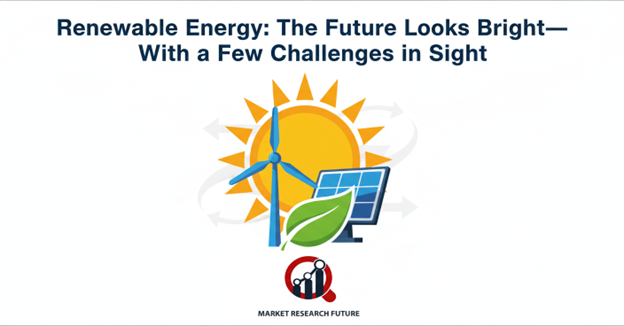Renewable Energy: Future Looks Bright with a Few Challenges in Sight

Renewable Energy Market Overview
The global renewable energy market is witnessing rapid expansion, driven by the urgent need to address climate change, reduce carbon emissions, and transition toward a more sustainable energy ecosystem. Solar, wind, hydro, and bioenergy technologies are at the forefront of this transformation, supported by strong government policies, corporate sustainability goals, and technological innovation.
Once considered an alternative, renewable energy has now become central to global energy strategies, with increasing investment in clean infrastructure and grid modernization. The rise of green finance, carbon-neutral commitments, and net-zero targets further boosts market momentum.
However, the journey toward a fully renewable-powered world comes with complex challenges—from infrastructure gaps and policy inconsistencies to cost pressures and supply chain limitations. Overcoming these barriers will require strategic innovation, policy alignment, and global collaboration to ensure accessibility, affordability, and scalability.
Despite these hurdles, the long-term outlook remains highly optimistic, with renewables poised to dominate global power generation in the coming decades.
What Is Renewable Energy?
Renewable energy refers to power derived from natural resources—such as sunlight, wind, water, and biomass—that are replenished naturally and are environmentally sustainable. Unlike fossil fuels, renewables produce little to no greenhouse gas emissions, making them essential for mitigating climate change.
Key renewable energy sources include:
- Solar Energy – Captures sunlight through photovoltaic or thermal systems.
- Wind Energy – Converts wind motion into electricity via turbines.
- Hydropower – Generates power from flowing or falling water.
- Bioenergy – Derived from organic matter like crops, waste, and wood.
- Geothermal Energy – Harnesses heat from within the Earth.
These technologies are increasingly integrated into smart grids, hybrid systems, and distributed energy networks, driving efficiency and reliability.
Shifting Global Energy Psychology
Consumers, governments, and corporations are increasingly prioritizing clean energy adoption as part of climate-conscious decision-making. The shift is influenced by:
- Rising awareness of climate change and environmental degradation
- Government commitments to net-zero emissions
- Corporate ESG (Environmental, Social, Governance) goals
- Consumer demand for green and ethical energy choices
- Technological innovations reducing cost per kWh of renewables
This evolving mindset has transformed renewable energy from an ethical choice to an economic and strategic imperative.
Key Market Growth Drivers
1. Climate Commitments and Policy Support
Global agreements like the Paris Accord and national renewable energy mandates are accelerating investments in clean technologies and grid infrastructure.
2. Technological Advancements
Innovation in solar PV efficiency, wind turbine design, battery storage, and hydrogen production is enhancing performance and reducing costs, making renewables increasingly competitive with fossil fuels.
3. Falling Costs and Economies of Scale
The cost of solar and wind energy has declined by over 80% in the past decade, allowing mass deployment and making renewables the cheapest source of new power in many regions.
4. Corporate Sustainability Initiatives
Businesses worldwide are adopting renewable energy procurement, power purchase agreements (PPAs), and carbon neutrality targets to meet sustainability commitments.
5. Energy Security and Independence
Renewables reduce dependence on imported fossil fuels, enhancing national energy security and resilience against price volatility.
Challenges in the Renewable Energy Market
Despite its strong trajectory, the renewable energy sector faces several hurdles that must be addressed to achieve global sustainability goals:
- Infrastructure Gaps: Many regions lack the transmission lines, skilled labor, and technical capacity to integrate renewable systems effectively.
- Fossil Fuel and Natural Gas Lobbying: Political and financial influence from traditional energy sectors often slows policy adoption and funding for renewables.
- Inconsistent Subsidies: Uneven government incentives and reliance on subsidies can make market growth unstable during financial downturns.
- High Labor and Installation Costs: Labor represents a significant share of renewable energy costs, and shortages of skilled workers can delay projects.
- Grid Compatibility Issues: Many developing regions rely on centralized fossil-based grids, making integration of decentralized renewable systems complex.
- Intermittency and Storage: Dependence on weather conditions requires investment in battery storage and smart grid management to ensure consistent supply.
Strategic policy alignment, investment in workforce training, and advancements in storage and transmission will be key to overcoming these constraints.
Regional Insights
- North America: Strong policy backing, green infrastructure funding, and corporate renewable adoption are driving growth.
- Europe: Leading in renewable integration due to strict emission laws, carbon pricing, and large-scale offshore wind projects.
- Asia-Pacific: Fastest-growing region, led by China, India, and Japan, supported by massive solar and wind installations.
- Latin America: Harnessing hydro and solar potential with rising investment from public-private partnerships.
- Middle East & Africa: Transitioning from oil dependency toward solar-rich energy diversification, though infrastructure remains a challenge.
Future Outlook
The future of renewable energy is bright and transformative. The sector is expected to dominate global electricity generation by 2050, with major advancements in:
- Grid-scale energy storage
- Green hydrogen
- Decentralized microgrids
- AI-powered energy management systems
- Sustainable supply chains and recycling
Global collaboration between governments, private investors, and technology innovators will accelerate progress toward a carbon-neutral world.
Conclusion
The renewable energy market embodies both promise and complexity. As the world races toward decarbonization, renewables stand as the cornerstone of a sustainable future. Despite challenges in infrastructure, policy, and cost, innovation and awareness continue to reshape the landscape.
With collective action, strategic investment, and technological breakthroughs, renewable energy will not only replace fossil fuels but also redefine global energy systems for generations to come.

Leave a Comment